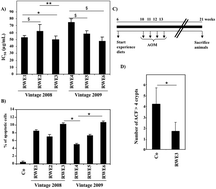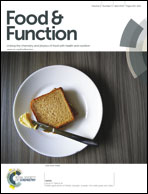Differential protective effects of red wine polyphenol extracts (RWEs) on colon carcinogenesis†
Abstract
Various epidemiological studies have shown that a regular and moderate consumption of red wine is correlated with a decreased relative risk of developing coronary heart disease and cancer. These health benefits are commonly attributed to high contents of polyphenols, particularly resveratrol, representing important sources of antioxidants. However, resveratrol does not seem to be the only bioactive compound present in the wine which contains numerous other polyphenols. The present study investigates the efficiency of red wine extracts (RWEs), containing different polyphenols, on colon cancer cell proliferation in vitro and on colonic aberrant crypt foci (ACF) in vivo. Proliferation, cell cycle analysis and incidence of ACF were monitored to examine the effects of RWEs. RWEs derived from a long vinification process exhibit superior anti-proliferative activity in colon cancer cells and prevent the appearance of ACF in mice. Interestingly, quercetin and resveratrol, representing two major bio-active polyphenols, exhibit synergistic anti-proliferative effects. These data suggest that the efficacy of RWEs on colon carcinogenesis may depend on the polyphenolic content, synergistic interaction of bio-active polyphenols and modulation of cellular uptake of polyphenols.

- This article is part of the themed collection: VI International Conference on Polyphenols and Health

 Please wait while we load your content...
Please wait while we load your content...